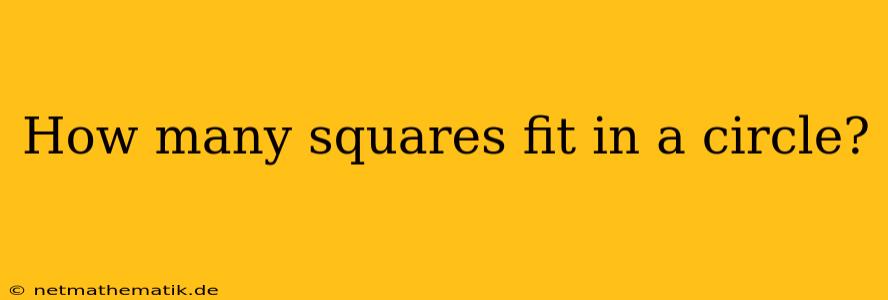The question "How many squares fit in a circle?" is a deceptively simple one. It might seem like a straightforward geometry problem, but it becomes far more complex depending on what you mean by "fit." If you're looking to find the largest square that can be entirely contained within a given circle, you're dealing with a classic geometric optimization problem. However, if you're considering the possibility of overlapping squares, the answer becomes much more nuanced, even infinite! Let's delve into this fascinating mathematical puzzle and explore the different approaches to finding the squares within a circle.
Finding the Largest Square Inside a Circle
The most straightforward interpretation of "How many squares fit in a circle?" is to find the largest square that can be inscribed within the circle. This means finding a square where all four corners touch the circumference of the circle. To solve this, we need to consider the relationship between the circle's diameter and the square's diagonal.
The Relationship Between Diameter and Diagonal
Imagine drawing a square inside the circle, with each corner touching the circle's circumference. Now, draw a diagonal line across the square. This diagonal line also represents the diameter of the circle. The diagonal of a square is related to its side length by the Pythagorean theorem:
- Diagonal² = Side² + Side²
- Diagonal² = 2 * Side²
Therefore, the side length of the square is:
- Side = Diagonal / √2
Since the diameter of the circle is equal to the diagonal of the square, we can express the side length of the square in terms of the circle's radius (r):
- Side = 2r / √2
Simplifying this equation, we get:
- Side = r * √2
Calculating the Area
Now that we know the side length of the inscribed square, we can calculate its area:
- Area of square = Side²
- Area of square = (r * √2)²
- Area of square = 2r²
This means the area of the largest square that can fit inside a circle is twice the square of the circle's radius.
Exploring Other Possibilities
While the inscribed square represents the largest single square that can fit within a circle, it's just one possibility. We can explore other configurations, including:
Overlapping Squares
If we allow squares to overlap, the number of squares that can fit inside the circle becomes virtually unlimited. We could fit an infinite number of tiny squares inside the circle, with each square becoming progressively smaller.
Packing Problems
Another approach is to consider "packing problems," where we try to fit as many squares as possible into a circle, without any overlap. This becomes a complex optimization problem with no single definitive solution. The arrangement and size of the squares can vary depending on the specific constraints and optimization criteria.
Conclusion
The question "How many squares fit in a circle?" doesn't have a simple answer. It depends on how we define "fit" and the specific constraints we impose. We can find the largest single square that can fit within a circle, but we can also explore infinitely many other configurations by allowing for overlap or applying packing optimization techniques. This question is a fascinating reminder of the multifaceted nature of geometry and the endless possibilities that arise when exploring different arrangements of shapes.
